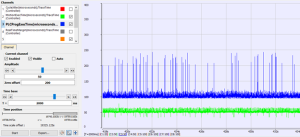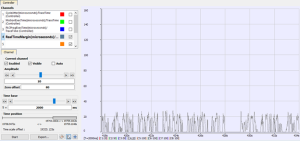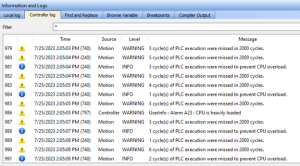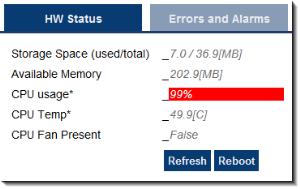Example: AKD PDMM and PCMM Over Loaded CPU
This example shows an application that is overloading an AKD PDMM or PCMM with the EtherCAT![]() ***EtherCAT is an open, high-performance Ethernet-based fieldbus system. The development goal of EtherCAT was to apply Ethernet to automation applications which require short data update times (also called cycle times) with low communication jitter (for synchronization purposes) and low hardware costs Cycle Time = 250 microseconds.
***EtherCAT is an open, high-performance Ethernet-based fieldbus system. The development goal of EtherCAT was to apply Ethernet to automation applications which require short data update times (also called cycle times) with low communication jitter (for synchronization purposes) and low hardware costs Cycle Time = 250 microseconds.
Specifically, this example looks at:
1. MotionExec and PLCProgExec Times
Using the techniques described in Practical Application: Using Trace Time To Measure CPU Load, examine the MotionExec and PLCProgExec times:
Figure 5-72: MotionExec and PLCProgExec Times
- The average MotionExec and PLCProgExec times are 57 + 110 = 167 microseconds.
- This is 67% (167 / 250) of the Cycle Time.
- Notice the big spikes on the PLCProgExec.
- The PLC
 "Programmable Logic Controller"
A Programmable Logic Controller, PLC, or Programmable Controller is a digital computer used for automation of industrial processes, such as control of machinery on factory assembly lines.
Used to synchronize the flow of inputs from (physical) sensors and events with the flow of outputs to actuators and events cannot complete all the programs within one cycle period.
"Programmable Logic Controller"
A Programmable Logic Controller, PLC, or Programmable Controller is a digital computer used for automation of industrial processes, such as control of machinery on factory assembly lines.
Used to synchronize the flow of inputs from (physical) sensors and events with the flow of outputs to actuators and events cannot complete all the programs within one cycle period.
- The PLC
2. RealTimeMargin
Figure 5-73: RealTimeMargin
- There is between 25 to 0 microseconds of margin.
- There are many cycles with zero real-time margin.
- This example shows up to 1 second of no real time margin available.
- This is a degraded case.
3. Controller Log
The Controller log confirms the missing VM cycles and an A23 alarm:
Figure 5-74: Controller log
4. CPU Load
Look at the overall CPU load.
- This is 99%.
- Clearly this application is overloading the CPU:
Figure 5-75: CPU load
See Also










